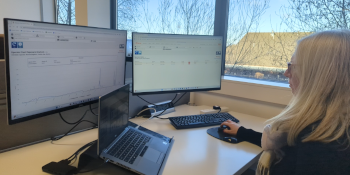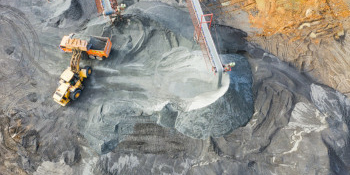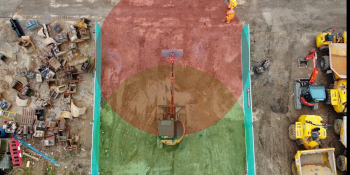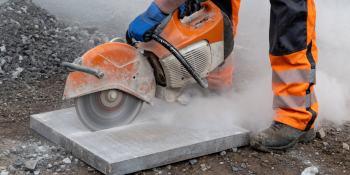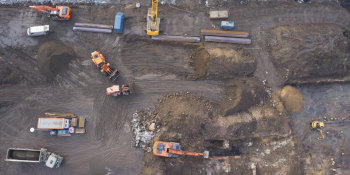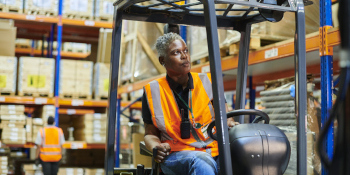Human Problems Require a Human Approach.
Human behaviour is inherently variable and uncertain, and any approach to monitoring a person’s behaviour must take these factors into account.
When it comes to monitoring a person’s exposure to HAV, a reliable metric is one that provides insight into the way that a person actually uses a tool, which includes frequency of use, operator competency, tool condition, and myriad of other - often unpredictable - factors. The traditional method for determining the risk posed to workers by exposure to vibration provides unrealistic, unrepresentative information because it relies on data from one person’s use of one tool during one activity at one point in time. Said otherwise: it doesn’t account for the variability or unpredictability that most certainly influences an individual’s actual, long-term exposure to vibration. This limited data is used to predict a person’s exposure moving forward, but the reality is that such restricted information is essentially useless for ascertaining a worker’s actual exposure to HAV over time. It’s simply impossible to utilise such finite data to make informed predictions about long-term exposure to unsafe conditions.
The foundation for this logic, that reliable, repeatable, reproducible information - information that is not collected in a vacuum - is the most representative and trustworthy available, underpins the field of predictive analytics (measuring behaviour to determine a future course of action), and it’s the bedrock of any calculation as to whether results you’ve gathered are meaningful and, most crucially, useful. Information need not be perfect - in most cases perfection isn’t possible - but any effort to collect sufficient data must attempt to ascertain the most accurate, most reliable, most robust results available. One person’s use of one tool during one activity at one point in time falls well short of this universally accepted standard.
It’s a bit like training for a marathon without an exercise monitor: if you embark on a training plan to run 26.2 miles but you have no data to inform how far you’re running or how fast, your assessment of your own progress will be incomplete, inaccurate and strictly retrospective. If you wear an exercise monitor, however, you’ll be able to view your running stats over time and better understand - and refine - your training behaviours. If, for example, you learn that your pace is consistently slower on warmer days, you could reasonably assess that your body performs better in cooler temperatures. From this information, you could make simple changes to increase your performance and avoid unnecessarily draining workouts: You could work out in the early morning or later at night when the weather is cooler, you could plan less challenging workouts on warmer days, and you could plan future races around cooler training times and seasons.
Similarly, this type of approach - a human approach - can be applied to assessing a workers’ exposure to HAV by evaluating real use data for individual workers using specific tools: It uses personalised, real-time monitoring to collect and collate information over time, and it provides valuable insights for workers and duty holders to act upon when it comes to reducing exposure to HAV, and offers more adequate, more representative information than traditional methods for evaluating worker behaviour. This kind of information - information that is most approximately right - is the key to guiding process refinement and driving meaningful results.
A Human Approach Protects Your Workforce And Your Bottom Line.
It’s clear that relying on generalised, incomplete data to implement a HAV-action plan simply doesn’t give you the information you need to adequately understand your workplace risk exposure. Personalised, more accurate data - like that provided by Reactec’s HAVWEAR - offers actionable information that can be used to refine controls and reduce risk. HAVWEAR informs workers of their exposure by calculating and displaying their risk assessment in real-time, and sound and vibration alerts inform workers if their personalised exposure thresholds have been exceeded. The data collected by HAVWEAR is then easily collated and disseminated to duty holders to further support appropriate, informed risk reduction initiatives.
The information provided by HAVWEAR is superior not because it is perfect - there is no such thing as a perfect metric for measuring an individual’s exposure to risk from HAV - but because it provides clearer, more approximately right information about workers’ exposure to dangerous workplace conditions than traditional methods, which fall well short of providing reliable data. In fact, the information gained by utilising such wholly outdated methods is so woefully inadequate that it is, essentially, precisely wrong. Moreover, these methods for monitoring worker behaviour and exposure to risk are a financial liability, especially when compared to the cost of getting connected with Reactec.
The cost of implementing and utilising HAVWEAR over the three-year life of the product is one-third as much as utilising a paper-based system to assess and address exposure to vibration over the same period of time. While it’s possible to measure and compare the cost of HAVWEAR to the cost of a paper-based system, what’s difficult to quantify is the difference between the level of insight and protection offered by this technology versus a manual option. That’s mostly because it’s like comparing apples and oranges: when it comes to the data and support available through sophisticated analytics versus pen-to-paper record keeping, the playing field simply isn’t level.
In fact, it’s clearer than ever that generalised assessments of risk are inadequate to accurately assess exposure to HAV, a determination that’s reinforced by a 300% increase in HAVS-related financial penalties over the last five years. Additionally, the HSE reasons that it costs companies between £7,000 and £36,000 to process every £1,000 paid out in compensation claims, in addition to the amount paid for the claim and any associated legal fees. With over 2 million workers in the UK at risk of exposure to vibration on a daily basis, and given that employers tend to underestimate the risk of those most likely to develop HAVS by 76%, the potential for an employer to suffer a meaningful financial loss is real and immediate.
Fortunately, the option to implement a system that can help companies more accurately monitor and reduce their workers’ risk from exposure to HAV is also real and immediate, and it’s cost-effective. Relative to the cost of damage control, prevention is - to state it plainly - a bargain.
In the case of a £500k fine recently levied by the HSE against an employer for failure to control exposure to unsafe levels of vibration, the total cost to provide HAVWEAR to the three workers affected for an entire year would have been one-quarter of 1% of the total £500k penalty. To provide protection to the same three workers for three years, dating back to when they were first diagnosed with HAVS, the total cost for HAVWEAR would have totalled just over £4k, or approximately 8% of the cost of the penalty ultimately paid by their employer.
It’s clear that faulty, incomplete data isn’t a reliable way to prevent risk in the workplace, and the numbers show that it isn’t an effective way to learn how to better protect your organisation, either. The only way to make sure your employees and business are exposed to less risk of HAV is to invest in tools that give you the actual knowledge you need to understand and address the issue - tools that take a human approach to measuring exposure to HAV.
Tools that help you work smarter.
Tools that help you become more exact, and less exactly wrong.

